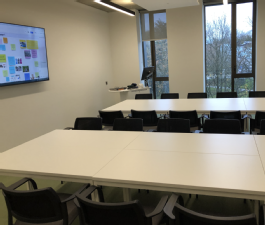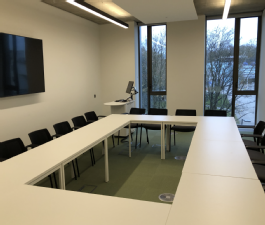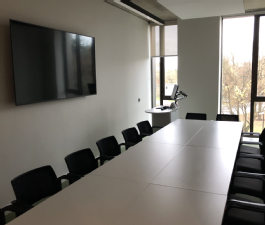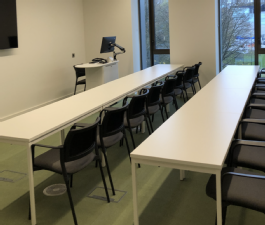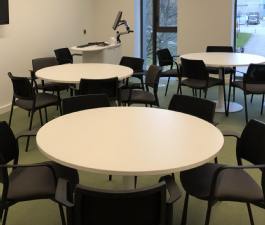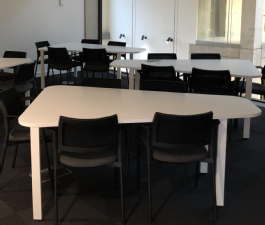Furniture and seating layouts in the FAB
This page documents our flat-floor teaching spaces and our tiered lecture theatres.
Flat-floor teaching spaces
The flat-floor teaching spaces have a variety of different types of table, enabling different seating layouts. Prior to the commencement of teaching in late 2021, tables have been arranged in a wide variety of layouts. This has an impact upon teaching design and styles. Remember that face-to-face seating is good for conversation but bad for working collaboratively on paper or screens. Layouts that enable group work and/or discussion are bad for viewing presentations on the main screen. The tables can be moved. They need to be cleanly lifted off the ground as they do not have wheels. Please note that they are heavy and require two people to safely move each table. Also note that many room arrangements have some students facing away from the main screen, so that when viewing a presentation, some students need to move their chairs around. Chairs and tables do not have wheels.
Table types and layouts
Large rectangular. On their own these tables can seat six tightly packed. However, they are usually arranged together to create greater surface area with fewer seats. Be aware that most of these configurations result in students facing away from the main screen, and are therefore poor for presentation-based sessions.
Shallow rectangular. Some rooms have shallower tables, only suited to being placed in rows.
Common arrangements of the rectangular tables are:
|
10 seat large rectangle. Some students facing away from the screen. |
Big committee style. Good for whole class discussions. Don't use with the main screen. |
Long boardroom style. Fits into narrower rooms. Don't use with the main screen. |
Long thin rows. Most suited to watching a presentation at the front, but poor for dicussions. Shallow tables. |
None of these arrangements are particularly well suited to group work. Two other types of table are more suited to group work:
Round cabaret style. Often arranged with five seats in "cabaret" style, however this leaves little space for a teacher to join the group. Good for disucssion. Bad for sharing paper docs or screens. Some students always facing away from the main screen and teacher, unless they turn. No gap in the seating layout for the teacher to join the group. See FAB 1.14 for a review of the benefits and drawbacks of round tables.
Triangular with flat nose. This seats five, and leaves space at the flat nose end for the teacher to join the group. Good for giving feedback and guidance. Good for disucssion, bad for sharing paper docs or screens. Some students always facing away from the main screen and teacher, unless they turn.
Tiered lecture theatres
One lecture theatre has conventional shallow tables and seats in rows.
The other lecture theatre has groups of seats arranged around slightly deeper tables.

